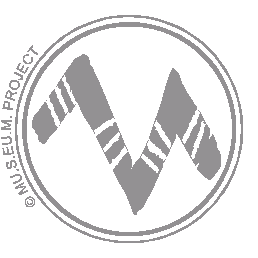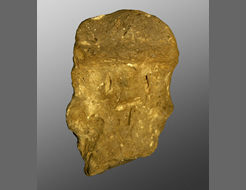|
||||||||||||||||||||||||||||||||
|
|
Museum of: Budapest | |||||||||||||||||||||||||||||||
| Name of the artefact: Idol head fragment | ||||||||||||||||||||||||||||||||
|
Roughly worked head of an idol from clay made lean with
sand and chaff. The eyes and the mouth are represented by short incisions,
the eyebrows by ribs in relief. The head is flat, the forehead receding.
|
||||||||||||||||||||||||||||||||
|
WHERE IS IT AND MAIN
CHARACTERISTICS |
STATE |
|||||||||||||||||||||||||||||||
|
Department: |
Department of Prehistoric and Migration
Period |
Preservation: |
Very good | |||||||||||||||||||||||||||||
|
Inventory number: |
BTM GY/1302 |
Restauration: |
Restored | |||||||||||||||||||||||||||||
|
Name of the artefact: |
Idol head fragment |
Completeness: |
Complete | |||||||||||||||||||||||||||||
|
Object type: |
Human figurine |
|||||||||||||||||||||||||||||||
|
Material: |
Clay with sand |
|||||||||||||||||||||||||||||||
|
Methof of manufacture: |
Hand made |
|||||||||||||||||||||||||||||||
|
Decoration
type: |
Incision |
|||||||||||||||||||||||||||||||
|
Distinctive mark: |
Depiction of the face |
|||||||||||||||||||||||||||||||
|
DIMENSIONS |
PERIOD OF USE |
|||||||||||||||||||||||||||||||
|
Length (mm): |
- |
Epoque: |
Neolithic Age |
|||||||||||||||||||||||||||||
|
Heigth
(mm): |
51 |
Culture: |
Transdanubian Linear Pottery
Culture |
|||||||||||||||||||||||||||||
|
Diameter
(mm): |
- |
Period: |
Middle Neolithic Age |
|||||||||||||||||||||||||||||
|
Width (mm): |
33 |
Face: |
Middle |
|||||||||||||||||||||||||||||
|
Thickness (mm): |
- |
Absolute chronology: |
5200-4900 BC |
|||||||||||||||||||||||||||||
|
Weight
(g): |
30 |
|||||||||||||||||||||||||||||||
DISCOVERY |
||||||||||||||||||||||||||||||||
|
Date: |
2004 |
Country: |
Hungary |
|||||||||||||||||||||||||||||
|
District: |
Budapest, XI |
Town hall affiliation: |
- |
|||||||||||||||||||||||||||||
|
Village: |
- |
Discovery findspot: |
Budapest-Kőérberek-Tóváros |
|||||||||||||||||||||||||||||
|
Condition of discovery: |
Chance Discovery |
Discovery type: |
Deposit |
|||||||||||||||||||||||||||||
|
ANALYSES – DETERMINATIONS |
FILLED IN BY |
|||||||||||||||||||||||||||||||
|
Type: |
- |
Name: |
László András Horváth |
|||||||||||||||||||||||||||||
|
Laboratory: |
- |
Institution: |
Budapest History Museum |
|||||||||||||||||||||||||||||
|
No./Code: |
- |
Date: |
20/10/2005 |
|||||||||||||||||||||||||||||
|
DEEPENINGS |
||||||||||||||||||||||||||||||||
|
Morphology of the object: |
||||||||||||||||||||||||||||||||
|
Roughly worked head of an idol from clay made lean with
sand and chaff. The eyes and the mouth are represented by short incisions,
the eyebrows by ribs in relief. The head is flat, the forehead receding.
The rear of the head becomes narrow starting from the nape. On its two
sides two small knobs can be seen, perhaps to symbolize the arms. The rest
of the body can only be guessed, perhaps was once a statuette-like
form. |
||||||||||||||||||||||||||||||||
|
Decoration: |
||||||||||||||||||||||||||||||||
|
The facial marks are worked with both incised and
relief techniques. |
||||||||||||||||||||||||||||||||
|
Inscription: |
||||||||||||||||||||||||||||||||
|
- |
||||||||||||||||||||||||||||||||
|
Analogies: |
||||||||||||||||||||||||||||||||
|
This idol fragment resembles to some extent the idols
and other facial representations of the linear pattern pottery of the
Alföld region in Hungary (Domboróczky 1997, 2. kép; Domboróczky 1999, fig.
14, 15; Domboróczky 2001, Plate 9-10; Kovács 2001, 4. kép 10; Kalicz –
Koós 2000, 14. Kép 6; Kalicz – Koós 1997, Abb. 4, 1; Abb. 5, 3-4), but it
is also somewhat similar to the portrayal of human figures of the Körös
culture (Kalicz – Makkay 1977, Taf. 8, 1-2), although it does not exactly
match either of the two styles. |
||||||||||||||||||||||||||||||||
|
Interpretation: |
||||||||||||||||||||||||||||||||
|
The bottom of the idol was damaged during the
excavation, thus |
||||||||||||||||||||||||||||||||
|
Bibliography: |
||||||||||||||||||||||||||||||||
|
Horváth, L. A., Korom, A., Terei, Gy., Szilas, G.,
Reményi, L., Előzetes jelentés az épülő Kőérberek, Tóváros-Lakópark
területén folyó régészeti feltárásról. Preliminary report on the
archaeological excavation conducted parallel to the construction on the
territory of the Kőérberek, Tóváros Residental District. Aquincumi Füzetek
11 (2005), p. 137-167. L. Domboróczki: Füzesabony-Gubakút. Újkőkori falu a
Kr. e. VI. Évezredből = Neolithic village from the 6th Millennium B.C. In:
Raczky – Kovács – Anders (ed.) Utak a múltba (Paths into the past) Az
M3-as autópálya régészeti leletmentései (Rescue excavations on the M3
motorway) Budapest 1997, 19-25. Domboróczki, L.: Az újkőkor idősebb
szakasza ÉK-Magyarországon, a Heves megyei régészeti leletek fényében (The
older phase of the neolithic in North-eastern Hungary in the light of
archaeological finds from Heves County). In: Early farmers in Europe (A
korai földművelők Európában) 1999, 15-47. Domboróczki, L.: The excavations
at Füzesabony-Gubakút. Preliminary report. In: R. Kertész – J. Makkay
(ed.) From the mesolithic to the neolithic. Proceedings of the
International Archaeological Conference held in the Damjanich Museum of
Szolnok, September 22-27, 1996. 193-214. it is difficult to decide whether
it was intended as an independent statuette, or as a figure in relief
applied to the rim of a vessel. Kalicz, N. – Makkay J.: Frühneolithische
Siedlung in Méhtelek – Nádas (Vorbericht). MAIU 6 (1977) 13-24. Kalicz, N.
– Koós, J.: Eine Siedlung mit ältestneolithischen Hausresten und Gräbern
in Nordostungarn. In: . In: Uzdarje Dragoslavu Srejoviću: povodom
šezdesetpet godina života od prijatela saradnika i učenika (Ed. M. Lazić).
Beograd 1997, 125-135. Kalicz, N – S. Koós, J: Újkőkori arcosedéynek a
Kárpát-medence északkeleti részéből (Neolithische Gesichtsgefäße im
Nordosten des Karpatenbeckens). HOMÉ 39(2000) 15-44. Kovács, K.:
Tiszaszőlős-Aszópart. Az Alföldi Vonaldíszes Kerámia Kultúrájának korai
telepe (Előzetes jelentés). (Tiszaszőlős-Aszópart. Eine frühe Siedlung der
Alföld-Linienbandkeramik). Tisicum XII (2001), 79-89. |
||||||||||||||||||||||||||||||||

